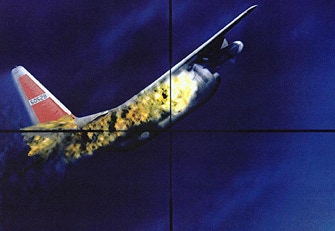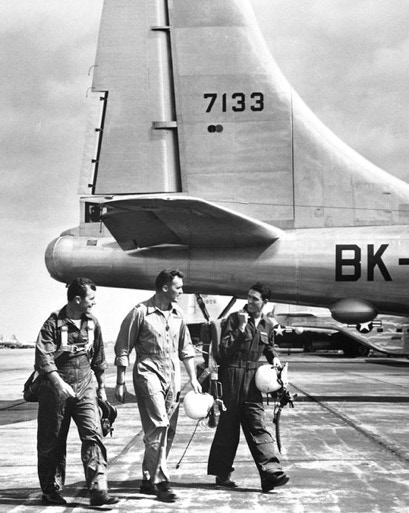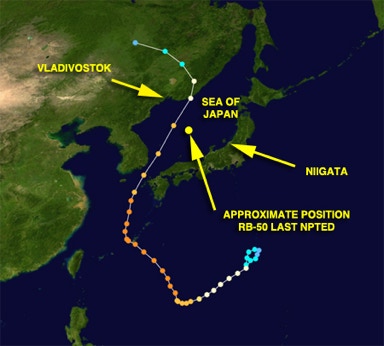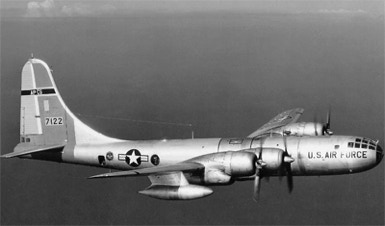DUTY, HONOR, COURAGE, RESILIANCE
Talking Proud: Service & Sacrifice

Airborne Peripheral Reconnaissance, Cold War Losses
“Silent Sacrifices”
USAF RB-50G , Sea of Japan, September 10, 1956
The failure of RB-50G serial number 47-133A to return to home base or any other Allied base on September 10, 1956, following a Sea of Japan reconnaissance mission remains a mystery. Sixteen Airmen were Missing in Action and then declared dead, eight from the 6091st Reconnaissance Squadron (RS) and eight from Det. 1, 6924th Radio Squadron Mobile (RSM). No one knows why she did not return from her mission. This photo shows the aircraft after an early test flight.
The 6091st RS crew consisted of Capt. Rodger Fees, Capt. William McLaughlin, Capt. Pat Taylor, 1st Lt Richard Kobayashi, 2nd Lt Peter Rahaniotes, A1C John Beisty, TSgt. Bobby Davis, and A1C Wayne Fair.
Eight USAF Security Service (USAFSS) people were on board from Det. 1, 6924th Radio Squadron Mobile (RSM). These eight included four Russian voice intercept linguists and one manual Morse intercept operator. Major Loren Disbrow, the commander of the USAFSS Det 1, 6924th RSM, was also aboard. The other USAFSS crew included TSgt Palmer Arrowood, SSgt Raymond D. Johnson, SSgt Theodorus J. Trias, SSgt Paul W. Swinehart, A1C William H. Ellis, A1C Harry S. Maxwell, and A1C Leo J. Sloan.
As events evolved, Typhoon Emma was tracking through the Sea of Japan at about the same time the RB-50G launched from Yokota AB, Japan
Emma was a severe typhoon with sustained winds of 155 mph, though winds had dropped considerably when she pushed through the Sea of Japan. Emma did considerable damage to Okinawa and South Korea before crossing through the Sea of Japan between September 10 and 11, 1956. The question that emerges is why the command authority sent this RB-50 out over the Sea of Japan when Typhoon Emma was known to be crossing it.
Paul M. Cole prepared a paper titled “POW/MIA Issues, Volume 2, World War II and the Early Cold War.” He noted,
“The aircraft was plotted by radar on the outbound course over the coast of Japan and again at 0549 hours while approximately 200 miles west of Niigata, Honshu, Japan. No further contact was made with the RB-50 or its crew.
“Typhoon conditions (typhoon track shown here) with winds ranging from 70-80 knots were present in the Sea of Japan caused by typhoon Emma. The crew had been alerted of the location of the typhoon. When the aircraft failed to return to Yokota Air Base, an immediate communications check was initiated with negative results.
“An extensive organized search followed, utilizing surface vessels operating in the Sea of Japan and many aircraft from bases in and around Japan. None of the missing personnel, survival equipment, or any wreckage was ever found.”
The Honolulu Star-Bulletin reported on September 11, 1956,
“Thirty US planes based in Japan scoured 70,000 square miles of sea in search of wreckage and life rafts. Several planes and 10 Japanese surface vessels continued the hunt.”
I wish to address a few issues associated with his flight.
Some reports say the RB-50’s mission was weather reconnaissance and that it chased Typhoon Emma. This is not correct. This RB-50G was not on a meteorological mission. This was a communications intelligence (COMINT) reconnaissance mission.
The book The History of Big Safari, by Colonel Bill Grimes, USAF (ret.), said this RB-50G 47-133 was “the first communications intelligence reconnaissance (COMINT) platform lost by US forces.”
Grimes explains this was a Project HAYSTACK mission. He wrote,
“The genesis of HAYSTACK was a USAF Security Service (USAFSS) experiment during the Korean War in which COMINT intercept operators flew out of Yokota AB, Japan, aboard RB-50s from the 91st Reconnaissance Squadron (which later became the 6091st RS). The success of the experiment was duly noted, and a request went to the Pentagon for a dedicated aircraft for the Airborne Communication Reconnaissance Program (ACRP) mission.”
RB-50G 47-133 had just arrived at Yokota AB, Japan, from Greenville, Texas, where it had been configured for COMINT reconnaissance. She carried four linguists and one manual Morse operator from USAFSS, trained to intercept Soviet communications, voice, and manual Morse.
Grimes continued,
“When the 47-133 delivered in June 1954, it was initially used for crew training and route familiarization prior to its fateful first operational mission on 10 September. When parked on the ramp at Yokota, 47-133 was separated from the rest of Yokota’s RB-50s and heavily guarded. Undoubtedly, the efforts to ensure operational security likely drew attention to its special status for any birdwatchers gathering intelligence for foreign interests.”
This procedure was standard for protecting aircraft with signals intelligence (SIGINT) and photographic equipment inside.
This mission was briefed as a top-secret reconnaissance mission to be flown at 20,000 ft. over the Sea of Japan on a top-secret route.
The National Security Agency (NSA) rated this a “probable shootdown.”
The NSA report, “Maybe you had to be there,” said the Naval Security Group SIGINT site at Kamiseya, Japan, known as USN-39, intercepted Soviet communications that,
“Reported preflight schedules for two IL-28 aircraft from the Soviet 50th Independent Reconnaissance Air Regiment at Novorossajskoe for 5.5. hour overflights of the search area. Three days after the apparent shootdown, USN-39 also reported that there were indications that at least one Soviet submarine was operating in the area of ongoing search operations in the Sea of Japan.”
It was routine for the Soviets to comb the area where an aircraft like this one crashed.
When it went missing, an Air Force spokesman discounted the idea it was shot down. However, the USAF later said,
“The USAF RB-50 ‘lost on typhoon,’ possibly the result of Soviet fighter attack. COMINT reflected tracking data on Soviet fighters.”
Paul M. Cole noted,
“On October 13, 1956, the US Embassy in Moscow requested the assistance of the USSR in obtaining whatever information they might have regarding the loss of the RB-50. A reply from the Soviet Government received on 13 November 1956 stated the Soviets had no knowledge of the fate of this crew.”
The Russians denied any involvement with this flight.
The crew was officially declared dead on December 31, 1956.
The Korean War Educator broached the matter of why the RB-50G did not return to base,
“RB-50G (47133) had just arrived at Yokota Air Base … There is speculation as to the cause of the loss of the 16 souls. One theory is that the plane was on the fringes of Typhoon Emma and was lost due to weather conditions. Another theory is mechanical failure. A third theory is that it was shot down by the Russians. The exact cause of the disappearance remains a mystery.”
The notion that the RB-50 became disoriented because of the typhoon, inadvertently violated Soviet airspace as a result, and then was shot down is plausible. A Soviet shootdown remains plausible even if the RB-50 did not violate Soviet airspace.
The International Missing Persons Wiki website, reporting on Capt. Rodger Fees, gave this theory, which may have some elements of truth to it,
“On September 10, 1956, Fees' crew was sent up to study wind velocities in the storm's right front quadrant. At some point over the Sea of Japan, the plane got caught in the storm and presumably crashed. It has been speculated that either the winds of the typhoon caused the plane to tailspin or that low pressures caused the plane's altimeters to give a false reading, causing the pilots to assume that they were flying much higher than they were, and making them fly lower until they crashed.”
As indicated earlier, this aircraft and this crew were not sent up to study wind velocities. They were sent up to intercept Soviet communications.
Japan’s National Institute of Infomatics (NII) presented this track of Emma. Emma crossed the Sea of Japan at about the same time the RB-50 was to fly over it. There was plenty of warning Emma was coming. Its power had already struck Okinawa, brushing along the Korean Peninsula on September 10.
I finish this report, once again asking, Why would the command authorities send this RB-50G out over the Sea of Japan when Emma was streaking through, and the area had a history of Soviet fighters shooting down USAF and USN reconnaissance aircraft? That is what I do not understand.
__________

Click to zoom graphic-photo
Table of Contents
- Introduction
- USN PB4Y2, Baltic Sea, April 8, 1950
- USN P2V Neptune, Sea of Japan, November 6, 1951
- USAF RB-29, June 13, Sea of Japan, June 13, 1952
- USAF RB-29, Sea of Japan, October 7, 1952
- USAF RB-50, Sea of Japan, July 29, 1953
- USN P2V, Sea of Japan, September 4, 1954
- USAF RB-29A , Sea of Japan, November 7, 1954
- USAF RB-47 , off-shore Kamchatka Peninsula, April 18, 1955
- USAF RB-50G , Sea of Japan, September 10, 1956
- USAF C-130A , Soviet Armenia, September 2, 1958
- USAF RB-47H , Barents Sea, July 1, 1960
- USAF RB-66C , East Germany, March 10, 1964




